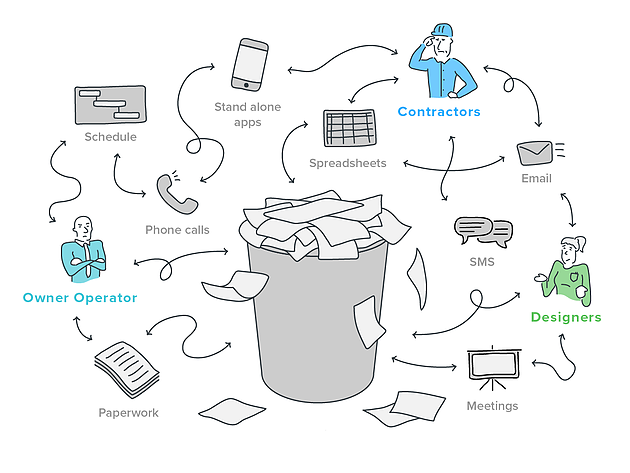Building Better Projects: The Function of Construction Document Management in Success
Building Better Projects: The Function of Construction Document Management in Success
Blog Article
Optimizing Job Partnership: Engineer's Ideal Practices in Building And Construction Record Monitoring
In the intricate world of building tasks, the reliable monitoring of building and construction files stands as a keystone for success. Engineers, with their careful attention to information and innovative style solutions, are tasked with coordinating a symphony of stakeholders, sources, and timelines. Among this intricacy exists a critical concern: how can engineers improve collaboration procedures to enhance task results? By checking out vital approaches such as leveraging cloud-based platforms, developing robust communication methods, and making sure data security, designers can boost their file monitoring methods to brand-new heights.
Leveraging Cloud-Based Systems
By transitioning from conventional paper-based systems to cloud services, architects can simplify collaboration, improve document ease of access, and improve total project effectiveness. This ease of access advertises smooth interaction and coordination among job stakeholders, leading to less errors and delays in the building and construction process.
Moreover, cloud-based systems supply a safe atmosphere for storing delicate project info, providing encryption, normal back-ups, and user approval settings to protect information integrity. Engineers can also gain from the scalability of cloud options, allowing them to readjust storage space capacity and performance based on job requirements. Generally, leveraging cloud-based platforms encourages designers to maximize their building record administration procedures, driving higher cooperation, performance, and success in their tasks.
Carrying Out Version Control Equipment
Having established the advantages of cloud-based platforms in building and construction file monitoring, architects can now boost their file control processes by implementing Variation Control Systems. Variation Control Solution (VCS) are necessary tools that track changes in papers, ensuring that staff member are always dealing with the most recent and most accurate details. By implementing VCS, designers can maintain a central repository where all project files are stored, enabling smooth partnership while reducing the danger of errors and variation disputes.
This attribute is specifically beneficial in building projects where style versions and modifications are common. This openness not just enhances responsibility however likewise assists in solving conflicts or discrepancies that might arise throughout the job lifecycle.
Establishing Communication Methods
To ensure effective and efficient project control, engineers must develop clear and durable interaction methods within their building and construction record monitoring procedures. This system can be a task monitoring software program, email threads, or cloud-based storage services.
Furthermore, communication protocols need to additionally consist of standards on exactly how to handle conflicts, change orders, and immediate problems that may arise throughout the task lifecycle. Developing an organized strategy to interaction makes certain that all stakeholders get on the very same web page, advertises transparency, and inevitably adds to the successful completion of the construction project.
Utilizing BIM Software for Coordination
BIM software program plays a pivotal function in boosting coordination among job employee in the construction sector. Structure Information Modeling (BIM) assists in cooperation by supplying a central system where designers, engineers, professionals, and other stakeholders can interact in a collaborated way. With BIM software, job participants can access and update a common design that has in-depth info about the structure design, construction parts, and job schedules.

Moreover, BIM software application enables real-time collaboration and interaction amongst team members, no matter their physical area. Via cloud-based BIM systems, job stakeholders can access the most up to date project information, track changes, and make notified decisions quickly. In general, leveraging BIM software for coordination enhances task performance, efficiency, and eventually causes successful project end results.
Ensuring Information Protection and Compliance
In the world of building and like it construction record management, securing data stability and making sure regulative conformity are vital factors to consider for designers and other project stakeholders. Engineers must implement durable protection actions to shield delicate job info from unauthorized access or violations.

Conclusion
Finally, architects can enhance project partnership in construction file monitoring by leveraging cloud-based Check This Out platforms, executing version control systems, establishing interaction protocols, using BIM software program for coordination, and making certain data safety and security and conformity. These finest techniques assist enhance the construction process, enhance interaction among project stakeholders, and improve performance in project delivery. By adhering to these guidelines, designers can properly manage building records and facilitate successful job end results.
Via BIM software, project individuals can access and update a shared version that consists of thorough details regarding the building style, construction parts, and task timetables.
Through cloud-based BIM platforms, project stakeholders can access the latest project information, track changes, and make informed decisions immediately - construction document management. Generally, leveraging BIM software program for control improves job effectiveness, efficiency, and eventually leads to successful job outcomes
In conclusion, this website architects can maximize task cooperation in building and construction paper administration by leveraging cloud-based platforms, executing version control systems, developing interaction procedures, utilizing BIM software for control, and making certain information protection and compliance. These finest practices help simplify the construction process, improve interaction amongst job stakeholders, and improve efficiency in task shipment.
Report this page